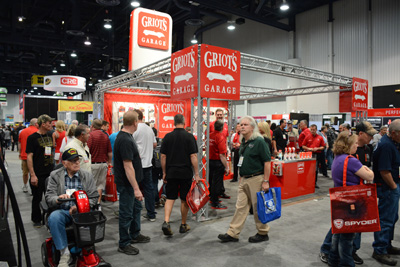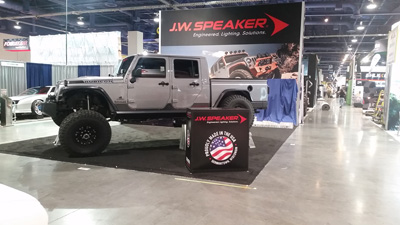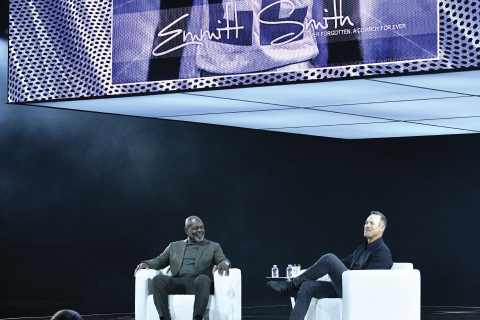SEMA News—September 2016
EVENTS
By Chad Simon
Keys to First-Time Success
Last Year’s Rookie Exhibitors Offer Advice on How to Plan for and Thrive at the SEMA Show
 Griot’s Garage exhibited in a 20x20 booth in the North Hall. This year, the company will expand to a 30x30 that will feature meeting rooms for large accounts. |
With more than 1 million sq. ft. of exhibit space in and around the Las Vegas Convention Center, the annual SEMA Show attracts 160,000 industry leaders from more than 100 countries. In 2015, the Show featured more than 2,400 exhibitors, including 400 first-timers. SEMA offers several tools—the Exhibitor Summit in particular—to help rookie exhibitors succeed.
We contacted three first-time exhibitors from the 2015 SEMA Show to find out about their experiences, strategies, what they learned and what advice they would offer to exhibitors who would be new to the Show this year. They included Richard Griot, owner of Griot’s Garage, a manufacturer of automotive appearance chemicals, accessories and tools; Jason Speaker, account manager for JW Speaker, a family-run, high-end LED light manufacturer; and Greg Cottrell, owner of Rugged Radios, a manufacturer of high-noise communication equipment for NASCAR, IndyCar and the Baja 1000.
SEMA News: Why did you decide to exhibit?
Richard Griot: We had attended the Show for 25 years to find vendors prior to exhibiting for the first time last year. We had always been a direct-to-consumer business via catalog, and our products can now be found in 12,000 retail chain stores.
Jason Speaker: We had walked the Show three or four times before, which we felt gave us a general knowledge of the Show, but exhibiting is a whole different ballgame. Since this is an industry show, many of our automotive customers are there, so it’s an opportunity to see all of them in one place. We were focused on getting our name out there, so we launched new products to not only our master distributors but also to their customer base and the general public.
Greg Cottrell: I needed to wait for the right time for my business, and we couldn’t have had better timing. We’re growing at a huge rate—more than 44% every year—so we made a statement to the industry when we came to the SEMA Show. You have to allocate a lot of resources to attend the Show, but on the other hand, the exposure and the contacts we made were absolutely huge. When you look at a cost factor, people always ask, “Do you make money going to the SEMA Show?” I can tell them absolutely yes. It brought us a substantial amount of business that we attribute to just being at the Show.
SN: Describe your overall experience.
 JW Speaker suggests planning ahead. The company featured an AEV Brute Double Cab in its booth, which took about three months of prep work. |
RG: We really went overboard on our booth design. We had a staff of seven or eight, and from the time the Show started, no one had a chance to breathe.
JS: There was a nervous excitement. It was a big investment for our company, but we accomplished our goals, which were to sign up a few major distributors and grow our brand within not only the off-road market but also the automotive market in general. We made some great connections and grew our international business.
GC: Some booths have so much going on that you don’t know what they are about when you walk up. But for us, with the backdrop we did, you knew exactly what we did when you walked up, and the vehicle that we brought (a brand-new Polaris RZR converted into an old-school Baja Bug) was absolutely huge exposure-wise. I also brought my fully restored Volkswagen Class 11 race car and put it outside. The tie-in of having a vehicle in our booth inside and having another one outside gave us a ton of exposure. Picking the right car and right theme is critical to an event like this. When I build something, such as the VW Bug, I look at the crossover value, because it relates to everybody.
SN: How did you promote your company and attract people to your booth?
RG: Our pre-Show strategy was to contact prospects and promote our presence, and it worked. We made about five million impressions and met with all of our major retailers.
JS: We sent a dedicated e-mail to all of our customers and used a network of manufacturer’s reps to ensure that they knew all the details. We hosted a sales meeting at our hotel for our manufacturer’s reps. The majority of our reps were already at the SEMA Show, so it just made sense to take advantage of their time and try to meet with everybody.
 Rugged Radios featured a brand-new Polaris RZR that was converted into an old-school Baja Bug in its booth and a fully restored Volkswagen Class 11 race car that was parked outside. |
GC: We took the approach of hitting social media hard. We also networked with other companies that were going to the Show. For instance, we cross-promoted with Cognito Motorsports. Build an environment of strong companies working together, because now you’re not just relying on your presence but also on their ability to reach their customers for you.
SN: What were your expectations and how did you prepare?
RG: We set the bar pretty low, because we didn’t know how many leads we would come away with. We were there to build a brand and put everyone else on notice that we’re now going after this end of the market. We’ve always been at the consumer level, and now we’re looking for distributors and wholesalers that can take our product to another level.
JS: We wanted to gain brand recognition. We went through a rebranding effort where we changed our logo to make it more universal. Our old logo just said “Speaker,” which was slightly confusing, since we sell lights and not audio equipment. We only sell through distribution, so I can’t say how much we’ve grown in that regard, but we are doing better in the automotive and off-road sectors this year than last year, and I would attribute a good portion of that to being at the SEMA Show.
To prepare, we went to the Exhibitor Summit last year, where we were able to talk to other manufacturers to see what worked and what didn’t. Nothing beats talking to other industry people. We threw a lot of manpower at the Show, and between our reps and company staff, we probably had close to one dozen people staffing our booth. We had a booth vehicle (an AEV Brute Double Cab) that we prepped for the Show, which took about three months. Plan that you’re going to need more time, because sometimes Murphy’s Law comes into play. Also, we had two light displays, which were effective in showing off our products. In our world, you have to see to believe. It’s hard to sell lights when you can’t turn them on.
GC: I thought if I could gain a few contacts and some exposure, that would be great. I wasn’t looking at it as “How much am I going to get out of it?” My expectations were to show the industry that we’re getting bigger and stronger. I was pleasantly surprised at how much I got in return. Two months after the Show, we looked at all the leads we called, and we learned that we made enough money to pay for all of our expenses and everything it took us to get to the SEMA Show.
SN: How do you define success and how will you improve this year?
 At the 2015 SEMA Show, Griot’s Garage launched the Boss tool—a professional orbital system with the correct polishes and pads so that detailers can perfect their vehicles. |
RG: Regardless of whether we got a sale, we achieved success at the Show in terms of brand exposure via the launch of the Boss professional orbital system. We were inundated with leads during the Show and could have used another two staff members. It’s more a matter of staffing after the event to ensure that we maximize what we’ve spent. We have also increased our booth size in order to accommodate more people, and we will have conference rooms to provide a quiet place to sit down with our large accounts. We will have a customized car on display outside to bring more people to our booth.
JS: We completed our goals, but branding is harder to measure. Our sales this year so far have already eclipsed last year’s sales, and I attribute a good portion of that to exhibiting at the SEMA Show.
This year, we will have an island exhibit to enable people from all directions to enter our booth. We spent a lot of time marketing ourselves, which we will continue to do because of the turnout we had. We’re going to start scheduling customers to come to the booth now, reserve dinner locations and get ourselves on our customers’ calendars, because everybody’s busy, and you want to be able to spend time with those you need to.
GC: I learned what product to bring. The SEMA Show attracts a diverse clientele. Last year, I set up two fire-truck intercom installers. My guys asked me why we were even bringing this to the Show; we’re in the off-road section. You never know who is going to walk up to your booth, so show the diversity in what you do. Don’t have a flyer for just one area of your business. Have information for all parts of your business. This year, we’re going to increase our booth space and do a retro old-school build. We’re also looking at our staffing, because each year, you need to show that you’re getting bigger and stronger, and increasing your presence is critical. Instead of having one vehicle outside, we’re going to have two vehicles outside plus what we have inside.
SN: What advice would you offer to future first-time exhibitors?
RG: Go to the Exhibitor Summit and start planning early; don’t wait until the last minute. Finish planning and preparation by October 1. The real work starts after the Show ends.
JS: Before exhibiting, walk the Show floor and talk to SEMA staff about it. Talk to other companies in your particular market. Plan as best as you can, knowing that not everything will go according to plan, especially once you get to the Show. Market yourself to your customers on your website and through social media that you’re going to be at the Show, and give them your booth number. Your customers are going to make a list of all the exhibitors they want to see, and they should know where your booth is located.
GC: If you’ve never exhibited, make sure that it’s the right time and that you can utilize the leads, contacts and information you obtain. A lot of people obtain the information and don’t use it. SEMA supplies the vehicle. We have to get in and drive that vehicle. SEMA isn’t going to drive it for us.
For more information on the SEMA Show, visit www.SEMAShow.com.






